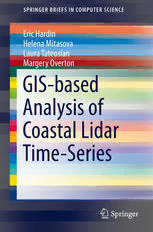Table Of ContentSPRINGER BRIEFS IN COMPUTER SCIENCE
Eric Hardin
Helena Mitasova
Laura Tateosian
Margery Overton
GIS-based
Analysis of
Coastal Lidar
Time-Series
123
SpringerBriefs in Computer Science
SeriesEditors
StanZdonik
ShashiShekhar
JonathanKatz
XindongWu
LakhmiC.Jain
DavidPadua
Xuemin(Sherman)Shen
BorkoFurht
V.S.Subrahmanian
MartialHebert
KatsushiIkeuchi
BrunoSiciliano
SushilJajodia
NewtonLee
Moreinformationaboutthisseriesathttp://www.springer.com/series/10028
Eric Hardin • Helena Mitasova (cid:129) Laura Tateosian
Margery Overton
GIS-based Analysis of
Coastal Lidar Time-Series
123
EricHardin HelenaMitasova
DepartmentofPhysics DepartmentofMarine,Earth
NorthCarolinaStateUniversity andAtmosphericSciences
Raleigh,NC,USA NorthCarolinaStateUniversity
Raleigh,NC,USA
LauraTateosian MargeryOverton
CenterforGeospatialAnalytics DepartmentofCivil,Construction
NorthCarolinaStateUniversity andEnvironmentalEngineering
Raleigh,NC,USA NorthCarolinaStateUniversity
Raleigh,NC,USA
ISSN2191-5768 ISSN2191-5776(electronic)
ISBN978-1-4939-1834-8 ISBN978-1-4939-1835-5(eBook)
DOI10.1007/978-1-4939-1835-5
SpringerNewYorkHeidelbergDordrechtLondon
LibraryofCongressControlNumber:2014947349
©TheAuthor(s)2014
Thisworkissubjecttocopyright.AllrightsarereservedbythePublisher,whetherthewholeorpartof
thematerialisconcerned,specificallytherightsoftranslation,reprinting,reuseofillustrations,recitation,
broadcasting,reproductiononmicrofilmsorinanyotherphysicalway,andtransmissionorinformation
storageandretrieval,electronicadaptation,computersoftware,orbysimilarordissimilarmethodology
nowknownorhereafterdeveloped.Exemptedfromthislegalreservationarebriefexcerptsinconnection
with reviews or scholarly analysis or material supplied specifically for the purpose of being entered
and executed on a computer system, for exclusive use by the purchaser of the work. Duplication of
this publication or parts thereof is permitted only under the provisions of the Copyright Law of the
Publisher’slocation,initscurrentversion,andpermissionforusemustalwaysbeobtainedfromSpringer.
PermissionsforusemaybeobtainedthroughRightsLinkattheCopyrightClearanceCenter.Violations
areliabletoprosecutionundertherespectiveCopyrightLaw.
Theuseofgeneraldescriptivenames,registerednames,trademarks,servicemarks,etc.inthispublication
doesnotimply,evenintheabsenceofaspecificstatement,thatsuchnamesareexemptfromtherelevant
protectivelawsandregulationsandthereforefreeforgeneraluse.
While the advice and information in this book are believed to be true and accurate at the date of
publication,neithertheauthorsnortheeditorsnorthepublishercanacceptanylegalresponsibilityfor
anyerrorsoromissionsthatmaybemade.Thepublishermakesnowarranty,expressorimplied,with
respecttothematerialcontainedherein.
Printedonacid-freepaper
SpringerispartofSpringerScience+BusinessMedia(www.springer.com)
Contents
1 Introduction ................................................................... 1
1.1 MappingCoastalTerrainChange ....................................... 1
1.2 GRASSGISandSampleDataSet ...................................... 3
1.3 OrganizationofThisBook .............................................. 5
References...................................................................... 6
2 ProcessingCoastalLidarTimeSeries ..................................... 7
2.1 GeneralWorkflow........................................................ 7
2.2 AnalysisofLidarPointClouds.......................................... 9
2.3 ComputingDEMs........................................................ 11
2.3.1 MaskingSurveyedAreas........................................ 11
2.3.2 Binning........................................................... 13
2.3.3 SplineInterpolation.............................................. 14
2.4 EliminatingWaterSurfaceFeatures..................................... 19
2.5 CorrectingSystematicErrors............................................ 20
References...................................................................... 25
3 Raster-BasedAnalysis ....................................................... 27
3.1 CoreandEnvelope,DynamicLayer .................................... 27
3.2 Time-of-MinimumandTime-of-Maximum ............................ 29
3.3 Per-CellUnivariateStatistics............................................ 30
3.4 Per-CellRegressionAnalysis............................................ 32
References...................................................................... 34
4 FeatureExtractionandFeatureChangeMetrics ......................... 35
4.1 ShorelinesandShorelineMigrationRange............................. 35
4.2 ForeduneFeatures........................................................ 36
4.2.1 ForeduneRidgeLine ............................................ 37
4.2.2 ForeduneToeLine............................................... 39
4.3 CrescenticandParabolicDuneFeatures................................ 42
v
vi Contents
4.4 GeneratingTransects..................................................... 46
4.4.1 TransectsatUniformLocations................................. 46
4.4.2 TransectsatOptimizedLocations............................... 47
4.5 MeasuringLineFeatureChange ........................................ 51
4.5.1 ShorelineChange................................................ 52
4.6 MappingLocationandChangeofBuiltStructures..................... 55
4.7 DerivedParameters:StormVulnerabilityScale........................ 59
References...................................................................... 61
5 VolumeAnalysis .............................................................. 63
5.1 DEMDifferencing ....................................................... 63
5.2 LandscapeSegmentationintoBins...................................... 64
5.2.1 Long-ShorePartitioning......................................... 64
5.2.2 Cross-ShoreSegments........................................... 65
5.3 VolumeEstimationforSegments........................................ 67
5.4 VolumeChangeMetrics ................................................. 68
References...................................................................... 70
6 VisualizingCoastalChange ................................................. 71
6.1 ColorandReliefShading................................................ 71
6.2 PerspectiveViewsof3DSurfaces....................................... 74
6.3 ComparingMultipleSurfaces:MapSwipeand3DCross-Sections... 74
6.4 Animationsin2Dand3DSpace ........................................ 75
6.5 VisualizationwithSpace-TimeCube(STC)............................ 76
References...................................................................... 79
Appendix........................................................................... 81
1 SampleDatasets.......................................................... 81
2 ColorTables.............................................................. 82
Chapter 1
Introduction
Management of highly dynamic coastal landscapes requires repeated mapping
and analysis of observed changes. Modern mapping techniques such as lidar
increased the frequency and level of detail in coastal surveys and new methods
were developed to extract valuable information from these data using Geographic
InformationSystems.Inthischapterwediscussmappingofcoastalchange,on-line
dataresources,andthebasicsofinstallationandworkingwithopensourceGRASS
(GeographicalResourcesAnalysisSupportSystem)GISusedinthisbook.
1.1 MappingCoastalTerrain Change
The present day coastal landscape is the result of complex interactions between
naturalprocessesandanthropogenicactivities.Rapidurbandevelopmentcombined
with increased shore erosion and severe storm impacts create new challenges
for coastal management (Fig. 1.1). Quantification, modeling, and visualization
of short term evolution of coastal systems is needed to better understand the
impactsofnaturalprocessesandanthropogenicinterventions.Identificationofareas
susceptibletohighratesoferosion,accuratemappingofelevationandsandvolume
change and assessment of coastal vulnerability due to storm surge is critical for
responsiblecoastalplanningandmanagement(Stockdonetal.2007).
Numerousstudieshavedemonstratedadvantagesoflidarsurveysforassessment
of shoreline and dune erosion (Burroughs and Tebbens 2008; Overton et al. 2006;
Sallenger Jr et al. 2003; Stockdon et al. 2002). Lidar-based, bare earth Digital
Elevation Models (DEMs) have been widely used for quantification of beach and
dune volume change (Mitasova et al. 2004; Overton et al. 2006; White and Wang
2003),includingassessmentofmajorstormandhurricaneimpacts(Sallengeretal.
2006). The high density of lidar data points and near-annual frequency of coastal
mapping in some regions provide time series of elevation data that can be used
©TheAuthor(s)2014 1
E.Hardinetal.,GIS-basedAnalysisofCoastalLidarTime-Series,SpringerBriefs
inComputerScience,DOI10.1007/978-1-4939-1835-5__1
2 1 Introduction
Fig.1.1 CoastalmanagementchallengesonNorthCarolinaOuterBanks:(a)stormimpactsin
Rodanthe(HurricaneSandy,NCDOT2012);(b)beacherosioninNagsHead(HurricaneIsabel,
USGS2003);(c)sandtransportthreatenshomesandinfrastructure(Nor’easterAthena,NCDOT
2012)
to extract new information about spatial patterns of coastal dynamics using raster
andfeature-basedtechniques.Thechangesinlidartechnologyoverthepastdecade
produceddatasetswithdifferentaccuracies,scanningpatterns,andpointdensities.
For this reason, geospatial analysis, when applied to multi-year lidar time series,
also needs to address the issues of accurate data integration and computation
of a consistent set of elevation models. Advanced three-dimensional Geographic
Information Systems (GIS) provide a means for efficient integration of these new
types of measurements. Once this integration is complete, GIS can be used to
perform a wide range of sophisticated analyses and visualizations (Mitasova et al.
2011). This book explains both the necessary preprocessing and the subsequent
analysis accompanied by step by step instructions and scripts applied to data sets
fromtheNorthCarolinacoast.
Lidar data and imagery for the coastal United States can be downloaded from
the“DigitalCoast”,aNationalOceanicandAtmosphericAdministrationoperated
website(NationalOceanicandAtmosphericAdministrationCoastalServicesCen-
ter2010).Thewebsiteprovidestoolsforsearchingandpre-processingofdata,such
ascoordinatetransformationandgridding.Italsoallowsuserstoselectawiderange
ofdatatypesandformats,suchasallreturn,firstreturnorbaregroundpointsinthe
las/formatoranascii/textfile.Inthisbook,weusedataforthecoastofNorth
1.2 GRASSGISandSampleDataSet 3
Carolina (NC) downloaded from the “Digital Coast”. Additional data, including
extensivecollectionsofaerialimageryforNCareavailablefromtheNCDepartment
ofTransportation(NCDOT).HighaccuracyNCDOTbenchmarksmeasuredalong
the centerline of the highway NC-12 can be downloaded at http://www.obtf.org/
NC12Alignment/NC12.htm.Thesebenchmarkscanbeusedtoidentifyandreduce
systematicerrorinthelidar.
1.2 GRASSGIS and SampleDataSet
The examples in this book process and analyze coastal lidar time series using
the Geographic Resources Analysis and Support System (GRASS)—the free and
open source GIS, specifically the GRASS7.0 release. The software is available to
downloadforfreefromhttp://grass.osgeo.org/.Theeasiesttostartwitharethepre-
compiled binary packages with installers available for Linux, MS-Windows, and
Mac OS X. The basic terminology and data organization in GRASS7 is described
in the GRASS GIS Quickstart document (http://grass.osgeo.org/grass71/manuals/
helptext.html).
AfterinstallingtheGRASSsoftwarecreateadirectorywhereyouwillstoreall
GRASS data. Name this directory grassdata/. This directory is often referred
to as GIS data directory or GISDBASE. Within GISDBASE, GRASS data are
organizedintoprojectscalledLOCATIONS,whicharedefinedbytheircoordinate
system and spatial extent. When GRASS is started for the first time, you will
be provided an option to navigate to and choose to work within an existing
LOCATION,ordefineanewLOCATIONusingtheLocationwizard.LOCATIONS
aresubdividedintoMAPSETS,whichareusedtoorganizedataforsub-projectsor
fordifferentusers.EachLOCATIONhasaMAPSETcalledPERMANENTwhich
is used for storing the coordinate system information and baseline geospatial data
forthegivenproject.
Youcanfindalldatasetsusedinthisbookathttp://geospatial.ncsu.edu/osgeorel/
data.html. Before starting GRASS, download the data set northcarolina_
coast_spm.zip and unpack it in your grassdata/ directory. The data set
is provided as a LOCATION which includes North Carolina boundaries in its
PERMANENTMAPSETandaNagsHead_series/MAPSETwithtimeseries
of lidar-derived DEMs. The DEMs represent coastal topography along 1km of
shoreline at 1m resolution in the town of Nags Head, NC, next to Jockeys Ridge
State Park (Fig.1.2). The time series contains series of time snapshots starting
in 1996 (Mitasova et al. 2010). Additional data used in this book can also be
downloaded from this website. These include the point cloud series for Jockey’s
ridge and Rodanthe (JR_*_lidar.txt and R_*_lidar.txt respectively),
theroadcenterline(road_centerline.txt),andtheroadsurfacepointcloud
(DARE_BE*.txt).

